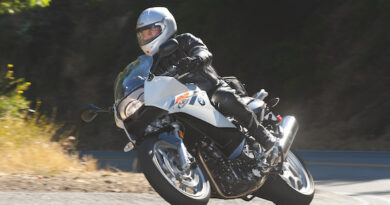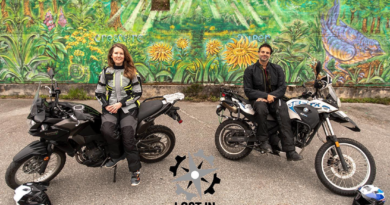Fear on Route 389
“What!?” I shouted at Janel while biting into a granola bar at a pullout along the highway.
“I said, do you want to take some photos!?” Janel screamed back, sitting on her bike a few feet away. Another large semi-truck screamed passed us, followed by the echoing sound of the wind it brought with it. In the five minutes we had been parked along the road, at least 50 large semi-trucks had flown past us at well over 100 km/hr (60 mph). The narrow road had dozens of pullouts for the truckers to take breaks, and we took full advantage of them, allowing our brains to recoup from all the truck dodging.
“Yeah, let me grab the camera,” I snuck between the noise of the convoy trucks.
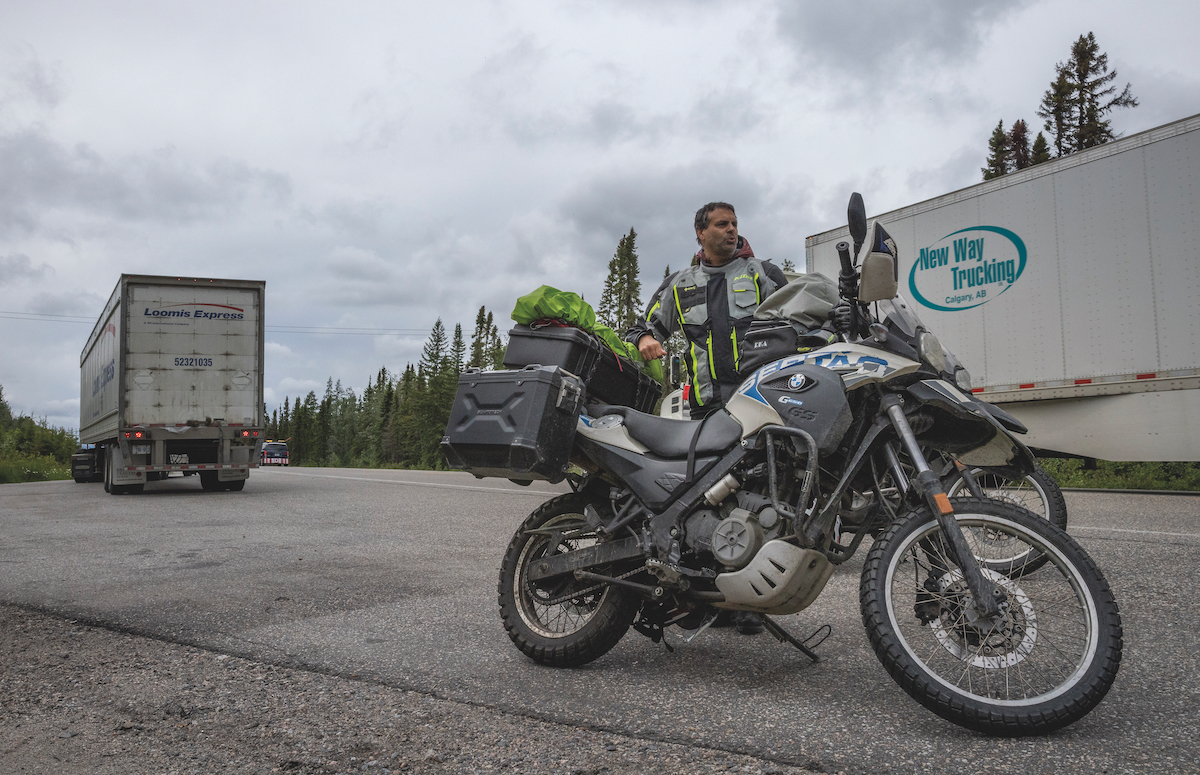
Ontario is known to road trippers as the “never-ending province.” Most Canadian provinces’ landmasses run north to south; Ontario’s, however, runs east to west. Even the shortest route across Ontario is 1,500 kilometers (930 miles) of mostly flat road. We decided to take the shortest route east as it would cut down on the driving time, put us into the more remote areas of Quebec when we crossed the border, and hopefully cut down on traffic. The first two points worked out great, but on the last one, we were just plain wrong. We didn’t realize it, but we had put ourselves on the main trucking route through Ontario.
It wasn’t all trucks; there were many deer, rabbits, friendly people, and small French-Canadian communities. Exploring was not on our agenda; however, the marathon of our cross-Canada trip had begun: 3,400 km (2,100 miles) in nine days, from West Hawk Lake, Manitoba, to Labrador City, Labrador. I realize this only averages around 380 km a day, but in the previous weeks, we averaged about 200 km a day with many days off. This was a giant leap. The distance wasn’t even the most challenging part, 170 km of the trip was stated as dangerous dirt roads with no cell service or support. At this point, we were all in, and I was excited.
The ride through northern Ontario was primarily uneventful: Janel continued to get better at riding (although she would never admit it), we did our best to stay out of the way of the trucks, and we tried to keep warm as the summer had not yet arrived in this part of Canada. We had our last Ontarian meal at a diner in the small town of Matheson. Sitting at a window table, we ate our sandwiches and watched as the dark clouds that had locked out the morning sun finally broke. On day three of our marathon, we covered 1,350 km (840 miles), and I could tell Janel was already tired. She was a little less cheery but never complained about the riding, only the rain and wind. I knew she was stressed about the ride along the dirt roads into Labrador; doubt had crept into her mind if she could do it. I did my best to stay positive, and as we left the diner into the afternoon sun’s warmth, I hoped Quebec would lift her spirits.
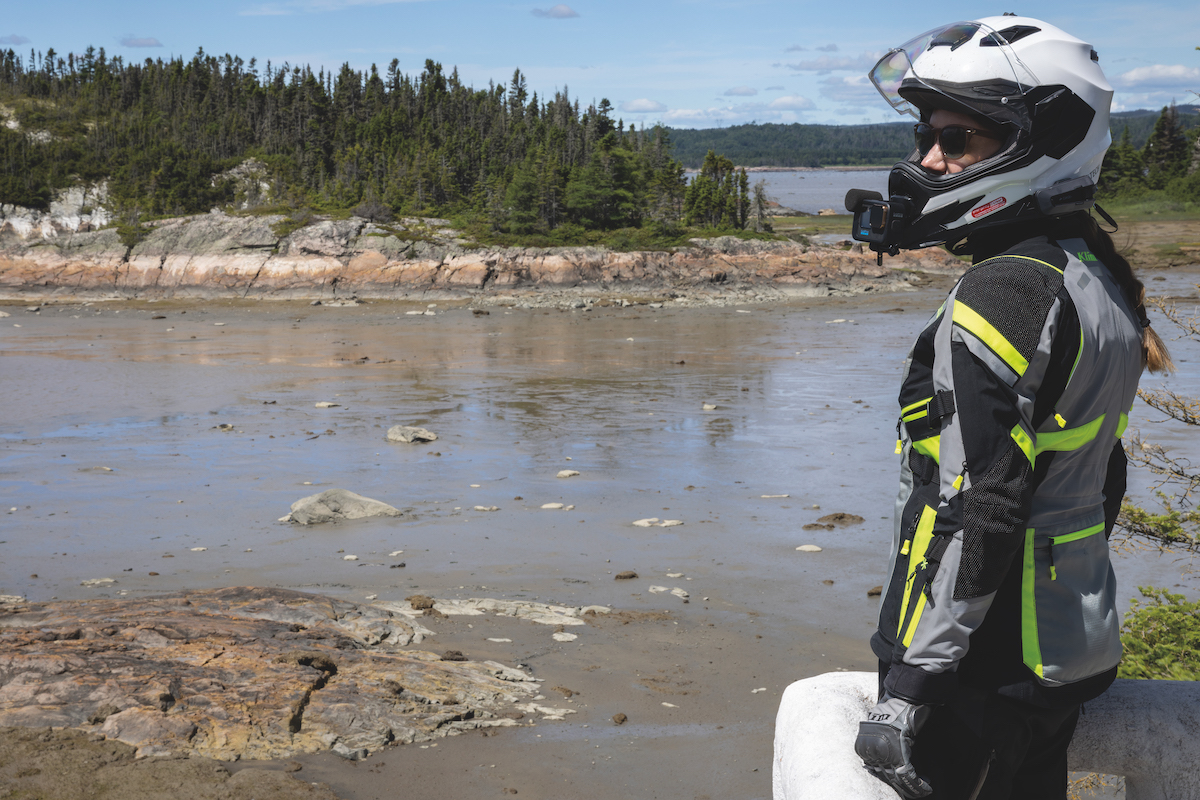
Crossing the border into Quebec, we felt an instant change in the atmosphere: traffic dropped to almost none, the semi-trucks were gone, and the trees grew close to the roads. We felt revitalized. The curves got more frequent, and as we came around one corner, sitting in the middle of the road was a black bear. After coming to a stop, I honked my horn several times, but the bear almost seemed irritated by the fact we wanted him to move off the road. Janel and I slowly crept the bikes forward while the bear stared, annoyed at us, until finally, our game of chicken ended with the bear sauntering off the highway and into the trees.
We rode out of the forests and into the farmland that is western Quebec. Large, colorful houses with vast amounts of land stretched over the horizon. It was beautiful but also confusing as most things looked the same, and our GPS wasn’t working all that well out here. Once we finally located our bed and breakfast for the night, we were fascinated by the fact our hosts did not speak English. Quebec and the rest of Canada are seen as very different (some of New Brunswick could be added in there, but I will address that in a future story); political ideas, language, and culture are contrasting between the two. Growing up on the west coast of Canada, Janel and I were not as exposed to the French Canadian language or culture as much as we should have been. As the kind hosts of our bed and breakfast tried desperately to converse with us, I felt a bit ashamed at my lack of speaking one of Canada’s two official languages. What surprised me the most, however, was less than 50 km away in Ontario, everyone spoke English and likely no French. The transition from crossing the border into Quebec was like passing into another country, not another province.
In the rest of Canada, Quebecois are rumored to be snobby about the French language; however, we never once encountered this as we continued through rural Quebec. The most common experience we had with people not speaking English was them apologizing to us for that fact. My response was always the same: “I am in your home; I should speak your language, which, in reality, is also my language.” The few times we were in areas with cell service, the Google Translate app got us through conversations. Most of the time, we used hand signals and would laugh our way through, asking simple things such as “What time is breakfast?”
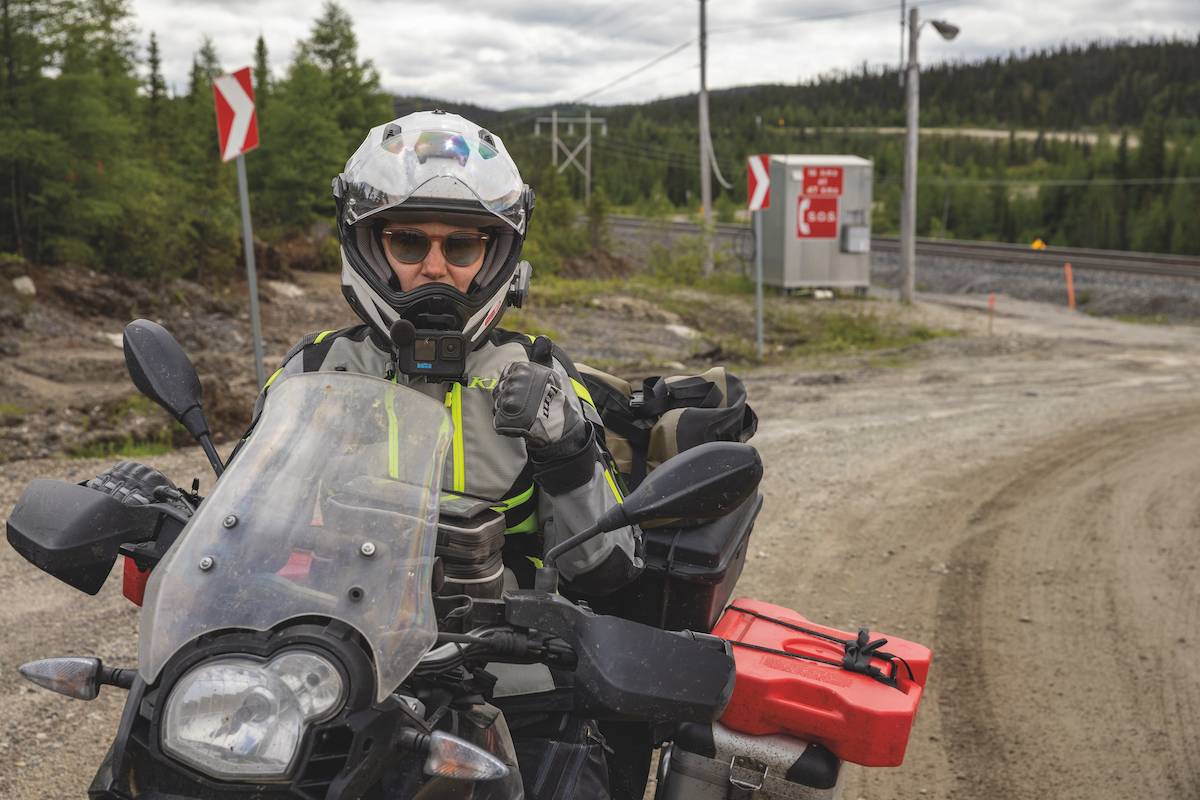
Another thing people on the west coast say is that people from Quebec are rude and unkind. We experienced the opposite. One example was on the third day of riding across the province when we arrived in another rainstorm at our bed and breakfast on Lake Saint-Jean. Tired and wet, we unloaded the bikes with the help of our hosts. We were on day five of the nine days and had ridden just over 2,200 km (1,370 miles). Janel was moving slowly, and I could tell she was tired from the riding, and being damp wasn’t helping the situation. When we rode into this rural area, I noticed there was nowhere to eat nearby, so as we pulled out one of our pannier bags, I told Janel to go inside and shower, and I would ride out to get us something to eat. Janel being Janel, she wouldn’t let me go alone and informed me we would both head out for dinner. I went in to tell our hosts we were off, and in their broken English, they said: “Do you want our car?” This was one of those moments where my Indian family would have been disappointed in me. It is almost a cultural rule that you politely decline any offer three times before finally accepting. Respecting my heritage was not on my list of priorities at that moment, and an astounded “YES!” came out of my mouth. The short drive into town was the first time we had been in a car in five weeks. It was nice to see the rain hitting the windshield instead of my visor and not worry about the cold wind blowing outside.
After our early afternoon dinner, we got to know our hosts’ farm animals. Janel fell in love with Pablo, the miniature horse, and I laughed as Janel tried her hands at milking what I can only say is the most patient goat on the planet. It was such a relaxing evening, and it felt like we were back to our normal one-day riding, one-day off. In the morning, we were refreshed and excited to start riding north toward Labrador.
Gas can be a problem for the 586 km (365 miles) of Route 389 that runs from the banks of the St. Lawrence River to Labrador City. Before heading out that first morning we gassed up and also topped up our jerrycans. The two gas stations along the route had been rumored not to have the highest quality fuel, and having engine issues along a route without cell service didn’t sound like a great idea. Packed and gassed up, we began the final two, likely most difficult, days of the marathon ride.
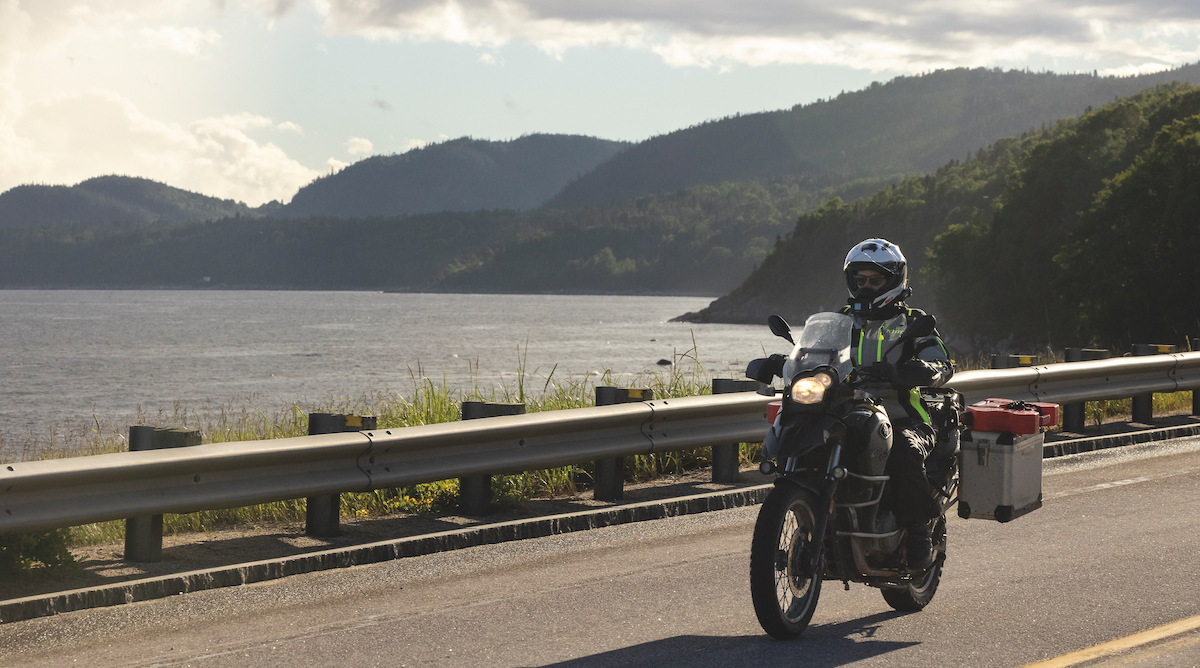
The first 214 km (132 miles) of Route 389 is curvy and well-paved. There isn’t a lot of traffic, and the curves make for a fun ride. The road was being rerouted, and construction was everywhere for the first 100km. Large dump trucks smashed along rocky construction roads, while backhoes used breakers to smash the rocks below, creating clouds of dust that hung in the air. I often checked my side mirrors to ensure Janel wasn’t falling behind in the curves, but the laughter in her voice while we spoke told me she was enjoying them as much as me.
Our destination for that evening was Manic Cinq generating station and Daniel-Johnson Dam. Turning a corner into the valley of the dam was a moment I will never forget: the dam loomed over us in all its shocking height and width, making us feel like tiny ants. I have seen the Hoover Dam, but the Daniel-Johnson Dam just took my breath away; it is monstrous. The dam is 1,310.6 meters long and 213.97 m high and features 14 buttresses and 13 arches. I really couldn’t believe the size of it. We were able to snag a tour of the dam that took us inside, outside and around, which made for a fascinating experience.
After our tour, we pulled into the local worker’s camp hotel for the evening. It was basic but had all we needed to get some rest before our final 372 km (231 miles) push to Labrador City. This section had over 170 km of bad dirt road that started the moment we left the dam site. It had some ugly torn-up pavement for a section, then the worst of the dirt was at the end, where we would zigzag train tracks. I knew Janel was nervous, but our goal was to leave early in the morning and take it slow.
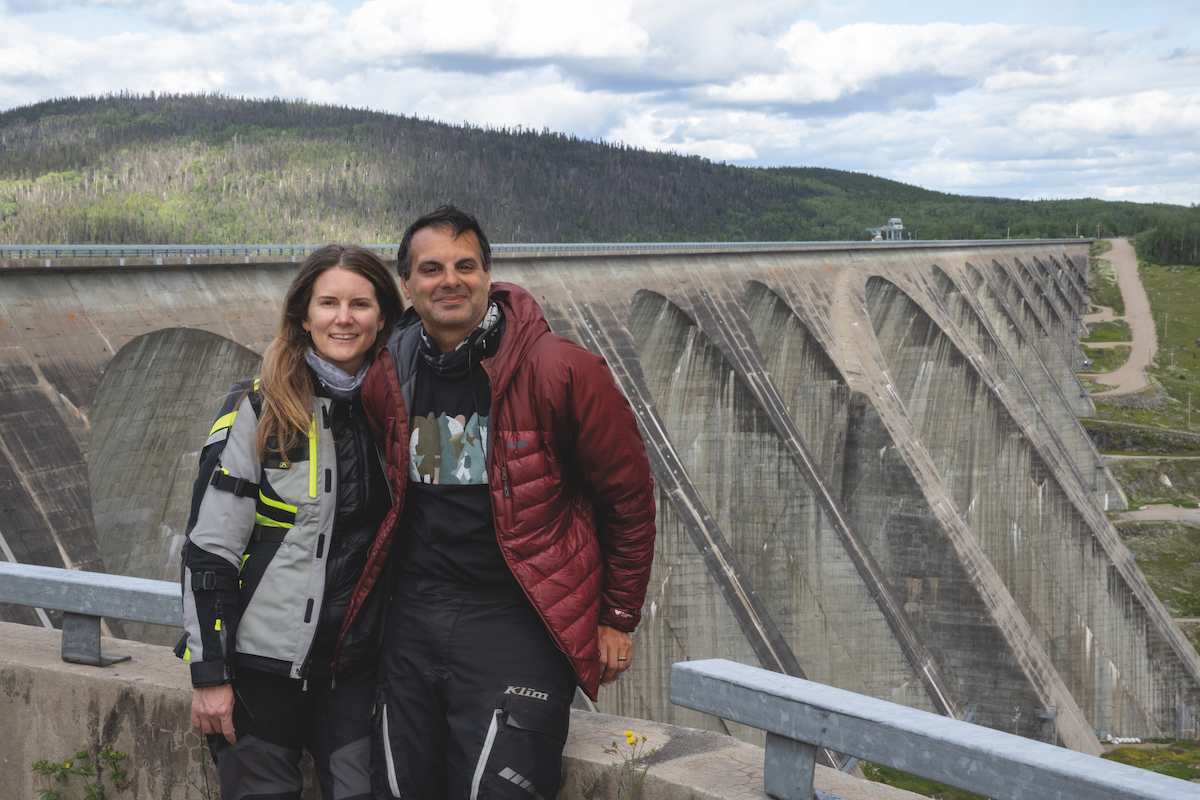
Loading up the bikes in the morning sun, I was excited. This was the section of road I was most excited to ride on the whole trip. I saw the concern on Janel’s face, but I knew she could do it. We did some warm-up stretches and headed to the top of the dam to get riding in the dirt. Janel took the first section of the dirt road well. She was nervous but soon was catching up to me, forcing me to go faster. Her confidence had bloomed over the past five weeks of riding across Canada, and I only heard concern in her voice when a semi-truck would pass us. The trucks were aware and respectful of our presence, leaving us lots of room as they passed, which was more than I could say for other parts of Canada. We came to the only shop along the route a little after two hours. There was gas there, but we had more than enough with our jerry cans to make it to Labrador City, so we pulled in, hoping to get some breakfast. The woman managing the shop was laughing and chatting with three other riders already there. She spoke English and was very sweet, but she was a little all over the place and eccentric. When I paid for my grilled cheese and a chocolate bar for Janel (yes, Janel had chocolate for breakfast that day), she charged me for one of the other rider’s gas fill up. The group of us, including her, all laughed at how all over the place she was, and it brought to mind how living in the middle of nowhere for an extended period can have some interesting effects on people. While enjoying our sandwich and chocolate, we spoke to the other riders on Harleys with 100% road tires.
“How are those tires on the road?” I asked.
“Probably not as good as yours.” One of them replied, laughing as he pointed out the window at our Motoz 50/50 tires.
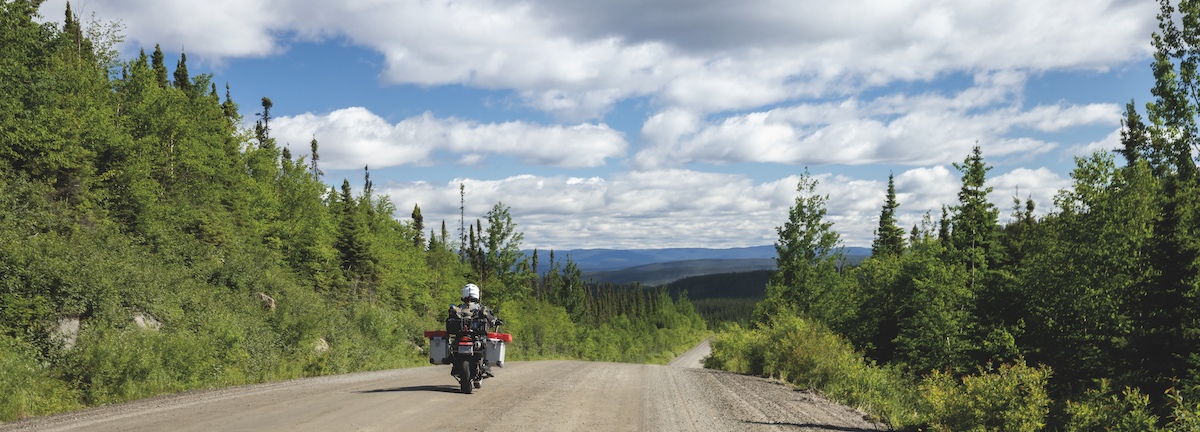
We had a short conversation with them about their ride, and they explained that while they were on the gravel, they were sticking to 50 kmh (30 mph). It was smart. There are a lot of accidents on this road when people don’t use the correct tires, and help can be a long ride away as there is no cell service for the extent of the highway.
Still having a long way to go, we didn’t want to spend too much time chatting. We left before the others, carrying on north and avoiding the massive potholes that now littered the paved section of the road. Once we were a short distance from the final gravel section that Wikipedia describes as “gravel: bad condition, very narrow and twisty,” we pulled over to fuel up the bikes. I was pouring Janel’s jerrycan into her gas tank when a trucker from Calgary came over to chat with us. He had driven this road many times and gave us some advice for the narrow road ahead: “look both ways at the train tracks, go slow through some of the corners because the trucks on the other side won’t be able to see you, and it isn’t as bad as the internet says it is.”
Taking his advice and our fueled-up bikes, we started the biggest challenge of this road trip. Readers are likely prepared for a big climatic story about how difficult the ride was or some intense deep brooding feeling that I had about the trip, but really, it wasn’t that bad. After about 30 km, I told Janel: “it looks like this was just graded,” About two km later, we caught up to the grader. The road was literally being graded for us as we went. There was almost no traffic, and we had to wait for one train at a crossing, but otherwise, the trip was uneventful.
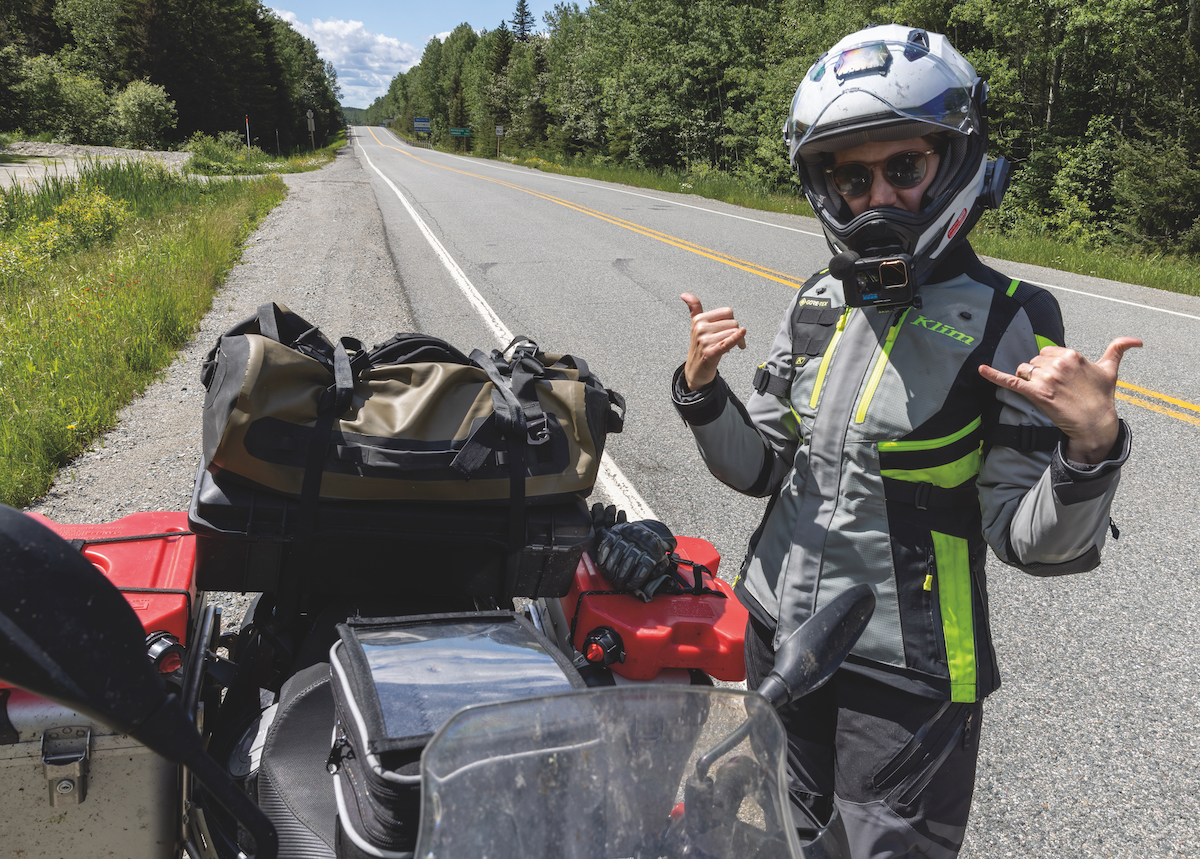
As we pulled up to the provincial sign of Newfoundland and Labrador, I laughed at how easy and uneventful this day was. The part Janel was dreading most of the whole trip, let alone the nine-day marathon, wasn’t all that bad. If I had to be honest, the 1,500 km of semi-truck-ridden highway across northern Ontario was far scarier and should instill much more fear than Route 389.
Where to stay, what to do, and where to visit as you ride to one Route 389
Gite Le Presbytere
Located across the border between Quebec and Ontario, this little bed and breakfast is a great inexpensive spot to grab a good night’s rest. This was also our first experience with a Quebec B&B breakfast, and I promise you will not leave hungry. They have three rooms that include breakfast, all CA$105/night (US$76).
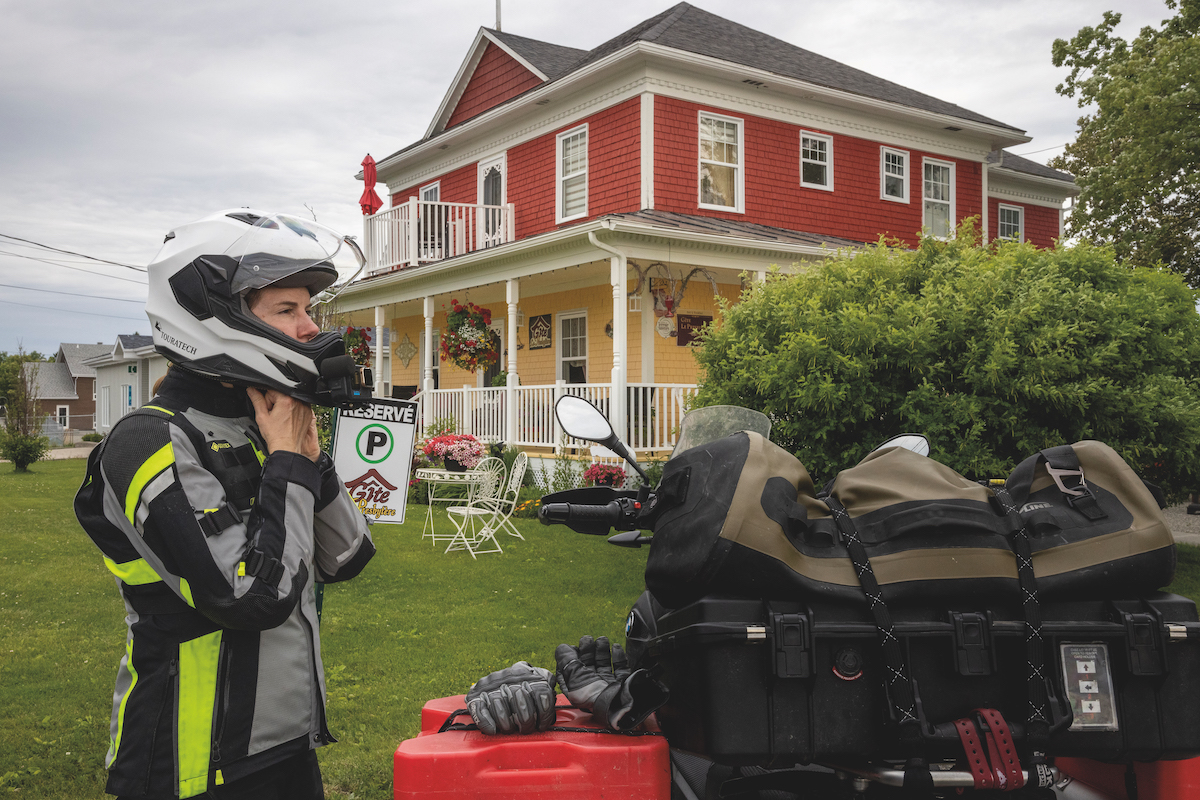
Vieille Ecole du Rang 3
Located on Lake Saint-Jean, this small one-bedroom B&B is fantastic. With farm animals to interact with, km of trails to wander, a hot tub, and canoes and kayaks, this is the perfect place to recoup if you have just ridden through western Quebec. Breakfast will not leave you hungry. The room is CA$130/night (US$94). They don’t have a dedicated website, but it will come right up if you Google the name.
Manic Cinq and Daniel-Johnson Dam
The dam tour was one of the highlights of our whole trip. As mentioned in the story, you go into the dam, on top of it, etc. If you don’t speak French, you get a private tour with an English-speaking guide. Well worth the stop. It is completely free; just make sure you book ahead.


